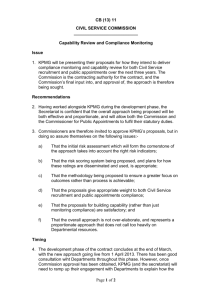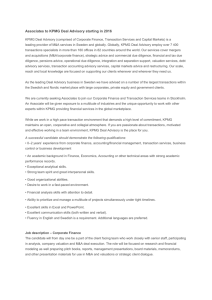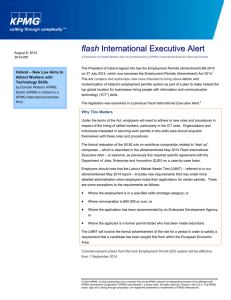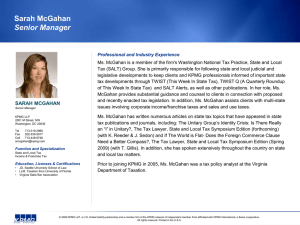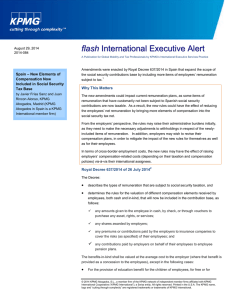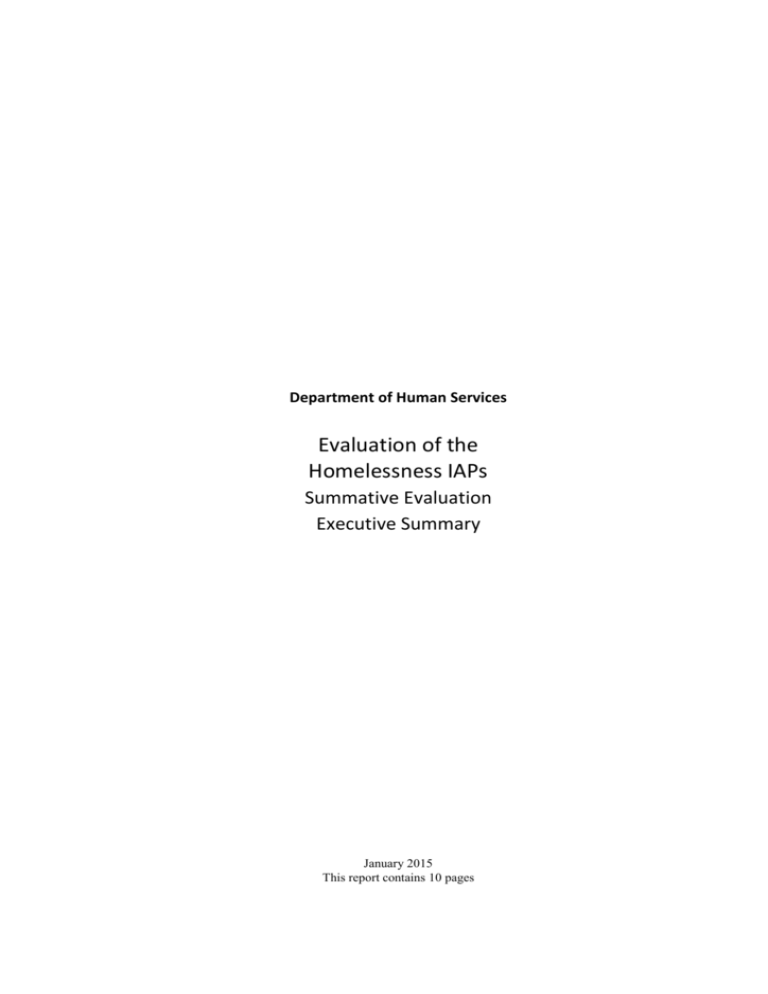
Department of Human Services
Evaluation of the
Homelessness IAPs
Summative Evaluation
Executive Summary
January 2015
This report contains 10 pages
Department of Human Services
Evaluation of the Homelessness IAPs
Final Report
January 2015
Inherent Limitations
This Executive Summary document has been prepared as outlined on page 1. The services provided in
connection with this engagement comprise an advisory engagement, which is not subject to assurance or
other standards issued by the Australian Auditing and Assurance Standards Board and, consequently no
opinions or conclusions intended to convey assurance have been expressed.
This Executive Summary document provides a summary of KPMG’s findings during the course of the work
undertaken for the Department of Health & Human Services (DHHS) under the terms of KPMG’s contract
dated November 2012. The contents of this Executive Summary document do not represent our
conclusive findings, which are only contained in KPMG’s final detailed report issued to the DHHS on 28
January 2015. Further, no warranty of completeness, accuracy or reliability is given in relation to the
statements and representations made by, and the information and documentation provided by the
DHHS’ management and stakeholders consulted as part of the process.
KPMG have indicated within this Executive Summary document the sources of the information provided.
We have not sought to independently verify those sources unless otherwise noted within the Executive
Summary document. KPMG is under no obligation in any circumstance to update this Executive Summary
document, in either oral or written form, for events occurring after the Executive Summary document
and/or KPMG’s detailed report have been issued in final form.
Third Party Reliance
This Executive Summary document is solely for the purpose set out in our contract with DHHS and is not
to be used for any other purpose without KPMG’s prior written consent.
This Executive Summary document has been prepared at the request of DHHS in accordance with the
terms of KPMG’s contract dated November 2015. Other than our responsibility DHHS, neither KPMG nor
any member or employee of KPMG undertakes responsibility arising in any way from reliance placed by a
third party on this Executive Summary document. Any reliance placed is that party’s sole responsibility.
This Executive Summary document may be made available on the DHHS website. Third parties who
access the Executive Summary document are not a party to KPMG’s contract with DHHS and,
accordingly, may not place reliance on this report. KPMG shall not be liable for any losses, claims,
expenses, actions, demands, damages, liabilities or any other proceedings arising out of any reliance by a
third party on the Executive Summary document.
Accessibility
To comply with the Victorian Government’s accessibility requirements for publishing on the internet, two
versions of this Executive Summary document are available: a KPMG-branded PDF version and an
unbranded Microsoft Word version. The KPMG-branded PDF version of this Executive Summary
document remains the definitive version of this Executive Summary document.
533570945 - 17 February 2016
© 2015 KPMG, an Australian partnership and a member firm of the KPMG network of independent member firms
affiliated with KPMG International Cooperative (“KPMG International”), a Swiss entity. All rights reserved.
The KPMG name, logo and “cutting through complexity” are registered trademarks or trademarks of KPMG International.
Liability limited by a scheme approved under Professional Standards Legislation.
Department of Human Services
Evaluation of the Homelessness IAPs
Final Report
January 2015
Executive Summary
The Homelessness Innovation Action Projects (IAPs) were an initiative established under the
Victorian Homelessness Action Plan (VHAP) to trial new methods of service delivery in the
homelessness sector. The IAPs specifically focused on early intervention and prevention of
homelessness delivered through integration service models. The IAPs were unique in that they
allowed the sector to drive innovation in designing and delivering services based on the
sector’s specialist knowledge and experience in delivering services to address homelessness.
The initiative was delivered in two stages:
Stage 1 comprised 11 projects trailing service models over an 18 month period from April
2012 to September 2013 with $15 million funding provided.
Stage 2 comprised a refined set of seven services (selected from the original 11 IAPs) which
were funded to continue to trial effective service models and, some to expand the models
implemented in Stage 1. A total of $15.9 million funding was provided for Stage 2 for the
period October 2013 – June 2015.
Through both stages, the projects were expected to demonstrate the capacity to deliver
coordinated and integrated approaches between specialist services such as family violence,
housing and homelessness, and more mainstream services such as health, education, and
employment services. In proposing projects, respondents were free from the constraints of
existing models of service delivery, resource allocation, and structural issues with flexibility in
how funding was packaged to support the achievement of client outcomes. The broad
parameters for project design meant that the sector was able to propose innovative service
models that would in turn inform future sector reform.
In line with the staged approach to implementation, the evaluation of the IAPs was also
staged. The interim evaluation was conducted during Stage 1 between October 2012 and May
2013 and the summative evaluation between October 2013 and October 2014. This is the
summative evaluation report, which in the main focusses on Stage 2 but also draws on the
lessons from Stage 1 and the interim evaluation.
Key findings: implementation
In moving to Stage 2 the IAPs made minor changes to their program models. Specifically:
The IAPs have refined the roles of their governance committees, transitioning them to a
more monitoring and accountability focused role, as opposed to having developmental and
implementation responsibilities as they did in Stage 1.
The nature of IAPs partnerships have matured and changed with some IAPs forming new
partnerships while other partners ceased participation.
There have been changes, both strategic and opportunistic, to the staffing complement
delivering the IAPs with some IAPs introducing new roles and others redefining roles within
the existing models.
1
© 2015 KPMG, an Australian partnership and a member firm of the KPMG network of independent member firms
affiliated with KPMG International Cooperative (“KPMG International”), a Swiss entity. All rights reserved.
The KPMG name, logo and “cutting through complexity” are registered trademarks or trademarks of KPMG International.
Liability limited by a scheme approved under Professional Standards Legislation.
Department of Human Services
Evaluation of the Homelessness IAPs
Final Report
January 2015
Three IAPs, Detour, Star Housing and HomeConnect Hub expanded as part of their
progression to Stage 2. The intent was to broaden the geographic reach and test the
transferability of the models.
While the changes from Stage 1 to Stage 2 were reported by the IAPs to have strengthened the
operational capacity to deliver, projects would have benefited from more active engagement
from the Department. To enable IAPs to drive improvements and continue to innovate, the
Department could have provided more feedback on program effectiveness, shared
information on evaluation findings and placed a greater focus on continuous action research.
Key findings: client outcomes
Outcomes were assessed quantitatively and qualitatively through the analysis of SHSC data,
outcome measurement data provided by IAPs, and client interviews, client case studies and
follow up surveys with exited clients. Key findings against each of the VHAP client outcome
domains are summarised below. These findings are reported in aggregate across all IAPs.
Access to safe and stable accommodation:
In the main the IAPs have positively influenced clients’ ability to maintain their current housing
or access new accommodation:
Noting that few clients were homeless at entry (23 per cent, n=655), nine percent of all
clients moved from being homeless (sleeping rough or in emergency accommodation) at
entry to not homeless on exit (nine per cent, n=245 or 37 per cent of all clients who were
homeless for whom a change in circumstances could be measured). Specialist
Homelessness Services system data shows that only 4 per cent of clients transitioned from
being homeless to not homeless by the end of the support period (19 per cent of all clients
who were homeless at the commencement of support).1
The follow up survey conducted with exited clients in Stage 2 indicates that the majority of
clients have maintained their accommodation three months after exit. Further clients have
reported, in the main that their current accommodation is relatively stable.
Clients perception of housing affordability three months after exit varied, with 52 per cent
(n=91) of clients describing their housing as affordable or very affordable, and 47 per cent
(n=82) reporting their housing as not so affordable, somewhat affordable or unaffordable.
For most clients, there was no change in condition of occupancy, reflecting that most of
the IAPs sought to support clients to achieve greater housing stability. Similarly, most
clients across all sites had no change in dwelling type and remained in a house/apartment.
These findings suggest that the IAPs have supported clients to stabilise their existing
housing arrangements or move to alternative housing of the same type and tenure.
1
AIHW 2013. Specialist homelessness services 2012-13. Cat. no. HOU 273. Canberra: AIHW – Supplementary Table VIC3.1: Clients,
Clients with closed support, by housing situation at first presentation and at end of support, 2012‒13, adjusted for non-response.
Note, 45 per cent of clients were reported as having an ‘other’ housing situation. It is not possible to determine whether these
clients were homeless or not homeless. Further, homelessness status at exit was not stated for 41 per cent of clients accessing SHS
services (n = 31,522).
2
© 2015 KPMG, an Australian partnership and a member firm of the KPMG network of independent member firms
affiliated with KPMG International Cooperative (“KPMG International”), a Swiss entity. All rights reserved.
The KPMG name, logo and “cutting through complexity” are registered trademarks or trademarks of KPMG International.
Liability limited by a scheme approved under Professional Standards Legislation.
Department of Human Services
Evaluation of the Homelessness IAPs
Final Report
January 2015
Engagement in education, employment and training
The majority of clients aged 16 years or more were not in the labour force (61.3 per cent,
n=1514) or unemployed (25.1 per cent, n=621) at the commencement of support. In part, this
is because two projects (Regional Outreach for the Elderly and Home at Last) specifically
targeted older people. Few clients have changed employment status, which is not surprising
given that employment outcomes can take some time to emerge. Further, most stakeholders
noted that addressing housing stability was a necessary precursor to enabling consistent
engagement in job seeking, education or training. Detour and HomeConnect Hub have
demonstrated some early positive education and employment outcomes, reflecting provision
of targeted support consistent with the project design.
Regular income source
Few clients changed their income source between entry and exit of an IAP service. Evidence
provided through qualitative case studies and client interviews suggests many clients have
been assisted to negotiate with Centrelink, change benefit type, and/or have been provided
with financial counselling which has improved their ability to budget and maintain regularity in
their cash flow.
Development of relevant life skills
Available Outcomes Star™ data, and other project specific outcome measures, provides some
evidence that IAPs have supported clients to develop relevant life skills, including
improvement in management of tenancy and accommodation and budgeting skills. Financial
management and budgeting was noted by all projects as a key area of skill development that
IAPs were able to influence. Case studies and client interviews further support this view.
Connection to family, friends and community
The qualitative data strongly suggests that where clients have been assisted into new
accommodation or to manage their finances this has positively impacted on their ability to
connect with social networks. In the case of projects working with young people, reestablishing relationships with was central to the program design, with case studies and
interviews evidencing the effectiveness of these approaches in supporting early intervention
and preventing homelessness. Available Outcomes Star™ data, and project-specific outcome
measures provides further evidence of progress toward achievement of this outcome.
Health needs are met
Qualitative interviews and available outcome measures suggest that for adult clients, there
was some evidence to suggest that the IAPs have positively impacted on the mental health and
wellbeing of clients. Client interviews and case studies highlighted the importance of housing
stability in positively impacting on mental health and wellbeing of clients, with many reflected
that the resolution of their housing issues had seen them improve in this area. Stakeholders
noted that in most cases, the capacity for IAPs to influence health outcomes was limited to
connecting clients to health services and supporting ongoing engagement in these services,
rather than directly influencing improved physical health outcomes. This is to be expected as
IAPs staff are not health professionals and therefore are unable to directly address clients’
health needs.
3
© 2015 KPMG, an Australian partnership and a member firm of the KPMG network of independent member firms
affiliated with KPMG International Cooperative (“KPMG International”), a Swiss entity. All rights reserved.
The KPMG name, logo and “cutting through complexity” are registered trademarks or trademarks of KPMG International.
Liability limited by a scheme approved under Professional Standards Legislation.
Department of Human Services
Evaluation of the Homelessness IAPs
Final Report
January 2015
Key findings: system outcomes
The evaluation explored the extent to which the IAPs had demonstrated achievement of the
VHAP service system outcomes. Key findings against each domain are summarised below.
Early intervention and prevention
The IAPs demonstrated that there is demand for early intervention and prevention services in
the homelessness sector, with strong evidence that the IAPs have intervened earlier than
traditional specialist homelessness services. At entry, 19 per cent of IAP clients reported
experiencing homeless in the month prior to presenting (n=495), compared to 32 per cent of
clients accessing specialist homelessness services in 2012/13 (n=17,324).2
This is to be expected given the policy intent for IAPs to focus on early intervention. Early
intervention and prevention was enabled through key design features such as: providing
community education; establishing mechanisms for earlier identification and targeting;
supporting clients demonstrating early signs of risk; and supporting clients to access services
earlier, by reducing the threshold for service access.
Integrated planning and service provision
At the local level, the IAPs have demonstrated evidence of integrated service provision,
primarily achieved through their established partnerships. Integrated service delivery has been
largely effective within existing relationships and DHS funded services evidenced by the profile
of IAP partnership participants. However, key challenges were experienced in extending
beyond traditional networks and referral pathways, related to:
Integrating with alcohol and drug, mental health and justice/corrections services. With the
exception of Next Steps, referrals from these services to IAPs were less than 1 per cent or
non-existent. In turn, IAPs reflected that high demand for these specialist services and
concurrent reform to the alcohol and drug and mental health services made it hard for
IAPs clients to access support and for these services to participate in partnerships. There
are continued opportunities for the Department and services to formalise links with health
services to support a more integrated response to client needs.
Constraints on the IAPs ability to influence the wider service system. There were a number
of systemic factors that impacted on the ability of the IAPs to integrate with other service
sectors, these related to differences in tools and systems used in different sectors and
policy and program changes being implemented at national levels (such as Centrelink
online service provision).
Maintaining momentum in the established partnerships. Some IAPs found that where they
had sought to engage large numbers of partners in Stage 1 there was considerable time
and effort required to maintain these relationships. In some circumstances partnerships
dissolved as there was limited input needed from partners in Stage 2.
2
AIHW 2013. Specialist homelessness services 2012-13. Cat. no. HOU 273. Canberra: AIHW – Supplementary Table VIC2.12:
Clients, by homeless status in month before first support period, 2012‒13, adjusted for non-response. Note, 34 per cent of clients
presenting to SHS services had ‘not stated’ for homelessness status in last month (n=38,345).
4
© 2015 KPMG, an Australian partnership and a member firm of the KPMG network of independent member firms
affiliated with KPMG International Cooperative (“KPMG International”), a Swiss entity. All rights reserved.
The KPMG name, logo and “cutting through complexity” are registered trademarks or trademarks of KPMG International.
Liability limited by a scheme approved under Professional Standards Legislation.
Department of Human Services
Evaluation of the Homelessness IAPs
Final Report
January 2015
The time, effort and resources required to enable effective partnership arrangements. The
IAPs reflected that there are considerable costs in terms of time, coordination, and
material resources for non-government organisations to be active participants in
partnership arrangements. As such, resource constraints impacted on the way other
services were able to partner with the IAPs.
Flexible and tailored support
The flexibility afforded to the IAPs with regard to how support is delivered to clients was highly
valued and contributed to the IAPs ability to build relationships with clients and deliver
outcomes. There was some evidence that IAPs provided flexible and tailored support, enabled
through: comprehensive screening and assessment at intake; streamed responses to suit
differing levels of client need; key worker approaches, supported by secondary consultation;
the provision of support for duration of need; and individual and tailored client case plans.
Flexible brokerage was identified as a key enabler of flexible support provision in that it
enabled IAPs to provide practical and immediate solutions to client need. In using flexible
brokerage analysis shows that brokerage funds were expended in line with local program
guidelines.
Outcome measurement
All IAPs faced challenges in conceptualising and measuring outcomes associated with their
projects. These challenges constrained the evaluation’s ability to interrogate outcomes in
depth, but also impacted on whether and how IAPs used data to interrogate the effectiveness
of their service delivery arrangements and continuously improve their projects. The experience
in measuring outcomes through the IAPs has highlighted the need to build capacity with the
sector in this area.
Key findings: cost effectiveness
The evaluation utilised a cost effectiveness analysis and avoided cost analysis to assess the
financial impact of the IAPs. The cost effectiveness of each IAP pilot was measured using five
indicators drawn from SHSC data: Income; Labour force status; Education status; Condition of
occupancy; and Type of residence. The outcomes achieved across cohorts in these areas were
measured based on project participant data collected at program entry and exit, with a scoring
system applied to reflect ‘no change’, ‘positive change’ and ‘negative change’ for participants.
It was assumed that the full measured change is attributable to the individual’s participation in
IAP and referral to other external services.
The evaluation found that Home at Last, Star Housing, and HomeConnect Hub were the most
cost effective in achieving outcomes across the five outcome areas, and in aggregate. These
IAPs may be perceived to be more cost-effective, as they provide shorter interventions to
(anecdotally) clients with less complex issues than other projects. In contrast, IAPs such as
Next Steps and Detour, that support clients over a longer period of time, are comparably less
cost-effective. In this respect, the cost-effectiveness analysis was not able to take into account
the complexity of client need and/or the duration and intensity of support required for clients
to achieve the specified outcomes.
5
© 2015 KPMG, an Australian partnership and a member firm of the KPMG network of independent member firms
affiliated with KPMG International Cooperative (“KPMG International”), a Swiss entity. All rights reserved.
The KPMG name, logo and “cutting through complexity” are registered trademarks or trademarks of KPMG International.
Liability limited by a scheme approved under Professional Standards Legislation.
Department of Human Services
Evaluation of the Homelessness IAPs
Final Report
January 2015
The avoided costs to government of funding the IAPs was determined by the difference in cost
between the base case (i.e. not funding the projects, estimated at $8.1m), and the cost of
supporting clients of the IAPs, including those clients for whom the intervention was not
effective and ultimately required SHS support ($7.9m). The Innovation Action Projects
therefore provided limited avoided costs for government of $162,000 at the whole of initiative
level. However, under all scenarios tested, Star Housing, HomeConnect Hub and Home at Last
collectively provided avoided costs of $2.15m suggesting that these projects may provide a
cost-effective means for diverting demand from specialist homelessness services. The
potential cost savings to government should be tested through further analysis when long
term data is available, via the SHSC, to more robustly measure the rate of diversion from
traditional homelessness services.
Key lessons
The evaluation has found that the sector highly valued the ability to innovate and test new
ways of working to intervene early in the cycle of homelessness. The majority of stakeholders
reflected that the decision to specifically fund innovation was a bold decision on behalf of
government, and a worthwhile exercise that should be continued in some form. As was the
intention of the initiative, the IAP experience has yielded a number of lessons many of which
will benefit decision making about system reforms. The lessons identified have been
aggregated into three broad themes:
1
Supporting and encouraging innovation, highlighting that:
Innovation exists along a continuum and there are benefits associated with incremental
change. The IAPs, though not implementing wholesale change, demonstrated new ways
that services could be conceived and delivered, yielding important insights for the
system.
Evidence suggests that an ongoing commitment to action research may have assisted
the IAPs to take stock of their programs more regularly, and drive continuous
innovation. To be fully effective, action research should be embedded in parallel to
design and implementation activities. Action research is an area that could be
considered in the development of future pilot program design.
Innovation needs to be supported by partnership between the not-for-profit sector and
governments.
Greater involvement of the Department in the design and
implementation of the IAPs had the potential to influence the scale and type of
innovation achieved. The nature of the way the IAPs were implemented did not allow
this opportunity to be realised.
2
Identifying elements of service delivery that show potential for wider application,
specifically, recognising the value of:
Early intervention responses. There was evidence of demand for early intervention and
prevention services and that these services are effective at preventing homelessness in
the short and medium terms. However it was acknowledged that systemic factors (e.g.
housing affordability), outside the influence of the homelessness services system impact
on the demand for and longer term effectiveness of early intervention services.
6
© 2015 KPMG, an Australian partnership and a member firm of the KPMG network of independent member firms
affiliated with KPMG International Cooperative (“KPMG International”), a Swiss entity. All rights reserved.
The KPMG name, logo and “cutting through complexity” are registered trademarks or trademarks of KPMG International.
Liability limited by a scheme approved under Professional Standards Legislation.
Department of Human Services
Evaluation of the Homelessness IAPs
Final Report
January 2015
Private rental advocacy and support works to prevent homelessness in an early
intervention context.
The key worker role in an early intervention context for its ability to connect complex
clients with the range of services they need.
Flexible service responses in terms of the nature and duration of support provided and
the use of flexible brokerage.
3
Understanding the homelessness sectors’ capacity to effect change within a broader
human services system, uncovering the following lessons:
The degree to which integrated plans can be used to best effect is impacted by
limitations within the existing system pointing to the challenges associated with the
absence of shared tools and resources across service systems.
Partnerships need to be adequately funded and resourced to facilitate participation,
identifying a range of capacity constraints impacting stakeholder’s ability to come to the
table to deliver integrated services.
There are opportunities to build capacity within the homelessness sector to support
wider change specifically with respect to program design and data management and
analysis.
Implications for system reform
In light of the above lesson the evaluation has identified a number of program elements as
worthy for consideration in the design of broader reform to homelessness services. They are:
early intervention and prevention services
flexible responses in terms of duration and type of support provided
private rental advocacy and support as a means of assisting people to stabilise and
maintain existing housing or access more appropriate/affordable housing
the use of key worker approaches, particularly for clients with complex or multiple needs
common case management tools and data capture processes to facilitate integrated
planning across service sectors.
These elements are consistent with the proposed features of Services Connect, which will be
trialled by the NGO sector in 2015.
The evaluation identified that there is a strong need for capacity building in the sector to
support outcomes monitoring with a view to enabling outcomes based funding approaches
into the future. Capacity building should incorporate:
the development of frameworks, tools and guidelines to support outcome measurement
approaches that build technical data management analysis skills in the sector
7
© 2015 KPMG, an Australian partnership and a member firm of the KPMG network of independent member firms
affiliated with KPMG International Cooperative (“KPMG International”), a Swiss entity. All rights reserved.
The KPMG name, logo and “cutting through complexity” are registered trademarks or trademarks of KPMG International.
Liability limited by a scheme approved under Professional Standards Legislation.
Department of Human Services
Evaluation of the Homelessness IAPs
Final Report
January 2015
sufficient resourcing to enable services to employ dedicated resources to drive
partnerships and collaboration, and are accountable for the management, monitoring, and
analyses of outcomes-based data.
These learnings apply equally to the homelessness sector and other human services sectors as
funding mechanisms increasingly shift from block or input funding, towards activity or
outcome based funding.
Moving to outcomes based funding arrangements
The IAP experience has highlighted that in addition to sector capacity building the following
features are important in the development of an outcomes based funding model for the
homelessness service sector. Key requirements include:
sufficient flexibility so as to enable a range of service responses to deliver on outcomes as
well as to fund capacity building and administrative (data) support
mechanisms that enable, and potentially provide incentives, to services to continue to
innovate and partner with others
a balanced approach to reporting on outputs and outcomes so as to maintain throughput
through the system, but emphasise the value of the achievement of outcomes.
encouragement of service providers to operate efficiently
administrative simplicity with clear and transparent decision making processes
minimal administrative burden on service providers and the funding body.
8
© 2015 KPMG, an Australian partnership and a member firm of the KPMG network of independent member firms
affiliated with KPMG International Cooperative (“KPMG International”), a Swiss entity. All rights reserved.
The KPMG name, logo and “cutting through complexity” are registered trademarks or trademarks of KPMG International.
Liability limited by a scheme approved under Professional Standards Legislation.



